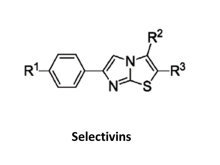BACKGROUND
Plant parasitic nematodes are microscopic worms that impose a severe economic burden on the agricultural industry. Their attacks have a direct impact on the quality and quantity of cultivated crops. To curtail their effects, chemical agents that reduce the fitness of nematodes, called nematicides, have become widespread throughout the world. However, the ecological toxicity and human safety of these chemicals has posed a problem and resulted in bans to some of the most used nematicides. Of the 20 key nematicides used over the last century, less than 20% are currently approved for use in the European Union and United States without restriction. This has driven a need to develop new nematicides with increased specificity to nematodes.
TECHNOLOGY
Researchers at the University of Toronto have developed the first bioactivatable nematicides. These molecules, called selectivins, have an imidazothiazole sub-structure that result in a toxic product after being processed by the nematode’s cytochrome p450 enzymes (CYPs) (Figure 1). As this conversion process occurs in nematodes and the toxic product remains contained within the nematode, selectivins provide selectivity for nematodes and likely reduce environmental and safety concerns. From a subset of selectivins generated, a lead compound has been identified.

COMPETITIVE ADVANTAGE
- More nematode selective that nearly all marketed nematicides
- No activity against the fungi, plants, insects, fish, and human cells tested
- Bioactivation is nematode specific
- Comparable efficacy to commercial nematicides
- At low parts-per-million concentrations, selectivins perform comparably well with commercial nematicides to control root infection by Meloidogyne incognita (the world’s most destructive plant-parasitic nematode)
- Broad-spectrum nematicidal activity
- Killed eggs of a nematode parasite of cattle, and the infective juveniles of two distinct species of root-knot nematode that infect crops
- New mode-of-action
- Industrially scalable synthesis
- Synthesis requires only two steps, two easily accessible solvents, moderate reaction temperatures and pressures, and no transition metal catalysts
- Uses inexpensive, easily accessible, and relatively non-toxic starting reagents
- Intermediates not purified or isolated between steps
APPLICATIONS
- Nematicides for plants
INTELLECTUAL PROPERTY STATUS
- National phase applications: US, CA (July 2020)
PROJECT STATUS
Selectivins have been identified as possible nematicides. Their mechanism of action (bioactivation by cytochrome-450 enzymes) has been identified and characterized. The phylogenetic specificity of selectivin bioactivation has been tested and found to be limited to nematodes. An analog series was conducted to identify a lead nematicide capable of controlling root infection by the root-knot nematode Meloidogyne incognita. The ability of eleven analogs to enabling growth of tomato seedlings in infected potted soil was tested and compared to all four of the marketed next generation soil-applied synthetic nematicides (fluensulfone, fluopyram, iprodione, and tioxazafen).





